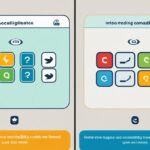Table of Contents
Welcome to our article series on universal design and its role in creating accessible and inclusive mobile apps. In today’s digital world, where mobile apps have become a significant part of our daily lives, it is essential to ensure that these apps are accessible to all users.
Universal design emphasizes the importance of creating apps that are inclusive, user-centric, and considerate of users with disabilities. By implementing universal design principles, developers can ensure that their apps can be used by a wide range of individuals, regardless of their abilities.
When designing accessible mobile apps, a user-centric approach is vital. By putting users at the center of the design process, developers can gain a deeper understanding of their needs and create apps that are intuitive and user-friendly. This approach considers aspects such as empathy, consistent experience, and user control.
Throughout this article series, we will explore the importance of accessibility in mobile app design, the user-centric design principles that contribute to accessibility, practical examples of accessibility features, testing and feedback for accessibility, and available resources and guidelines for accessible design.
Join us on this journey to learn how you can create mobile apps that are not only functional but also accessible and inclusive to all users.
The Importance of Accessibility in Mobile App Design
Accessibility is a critical consideration in the design of mobile apps, particularly for ensuring inclusivity and providing a user-friendly experience for individuals with disabilities. By prioritizing accessibility, developers can remove barriers that may impede users with disabilities from effectively accessing and utilizing the app.
Designing mobile apps with accessibility in mind involves considering the diverse needs of users with disabilities, such as visual impairments, hearing impairments, motor disabilities, and cognitive disabilities. By incorporating inclusive design principles, developers can create interfaces that are perceivable, operable, and understandable to a wider audience.
Making mobile apps accessible means empowering individuals with disabilities to fully participate in the digital world, ensuring equal access and providing a level playing field for everyone.
When mobile apps are designed with accessibility in mind, they become more user-friendly for individuals with disabilities, resulting in a more inclusive user experience for all users. Accessibility features such as adjustable font sizes, high contrast options, alternative text for images, closed captions, and intuitive navigation can benefit not only users with disabilities but also those without disabilities.
Creating Inclusive Interfaces
Designing interfaces with inclusivity in mind involves:
- Providing clear and easy-to-understand instructions for users with cognitive disabilities
- Using color combinations and contrast ratios suitable for users with visual impairments
- Implementing touch targets and gestures that are easily operable for users with motor disabilities
- Offering alternative means of communication, such as audio cues, for users with hearing impairments
By addressing these considerations, mobile app designers can ensure that their products are accessible and user-friendly to a diverse range of individuals.
Designing mobile apps with accessibility in mind not only enhances usability but also addresses legal obligations. Several countries, including the UK, have legislation in place that requires accessibility standards to be met in digital products and services. By prioritizing accessibility, app developers can not only avoid legal repercussions but also tap into a larger user base by catering to the needs of individuals with disabilities.
In the next section, we will explore user-centric design principles that further contribute to creating accessible and inclusive mobile apps.
User-centric Design Principles for Accessibility
User-centric design principles play a crucial role in creating mobile apps that are accessible and inclusive for all users. By prioritizing the needs of individuals with disabilities, designers ensure that their apps are intuitive, flexible, and responsive to the diverse needs of the user base. Let’s explore three key principles that drive user-centric design for accessibility: empathy and understanding, consistent experience, and user control.
Empathy and Understanding
Designers must develop a deep understanding of users’ needs and experiences to create truly accessible apps. By adopting an empathetic approach, designers can identify the challenges faced by users with disabilities and tailor their app experiences accordingly. This involves conducting user research, engaging with individuals with disabilities, and incorporating their feedback throughout the design process. By embracing empathy and understanding, designers can ensure their apps meet the specific needs of their users, promoting inclusivity and accessibility.
Consistent Experience
A consistent experience is paramount in making mobile apps accessible to users with cognitive or learning disabilities. By maintaining a predictable and uniform interface across all app functionalities, designers minimize confusion and enhance usability. Consistency in design elements, such as layout, navigation, and terminology, allows users to easily navigate the app and understand its features. Providing clear and concise instructions further contributes to a consistent experience, making the app more accessible to all users, regardless of their abilities.
User Control
Offering users control over their app experience is fundamental to accessibility. Designers should prioritize user control by incorporating customization options and flexible settings. Users with disabilities may require modifications such as adjusting font sizes, enabling text-to-speech functionalities, or altering color contrasts. By providing these options, designers empower users to adapt the app to their individual needs, creating a personalized and inclusive experience. User control ensures that all users can interact with the app effectively, regardless of their specific accessibility requirements.
By embracing these user-centric design principles, designers can create mobile apps that reach a wider audience while promoting accessibility and inclusivity. The next section provides practical examples of how these principles can be applied in real-world mobile app design.
| User-Centric Design Principles | Benefits |
|---|---|
| Empathy and Understanding | – Tailored app experiences for users with disabilities – Enhanced accessibility and inclusivity – User-centric design |
| Consistent Experience | – Ease of app navigation for users with cognitive or learning disabilities – Improved usability and user satisfaction – Clear instructions and intuitive design |
| User Control | – Personalized app experience – Adaptability for users with specific accessibility requirements – Increased accessibility and flexibility |
Practical Examples of Accessibility in Mobile App Design
Mobile app design plays a vital role in creating an inclusive digital environment. By incorporating practical examples of accessibility, designers can ensure that their apps are accessible to users with various disabilities. Let’s explore some key examples of how mobile apps can be designed to cater to different accessibility needs.
Visual Accessibility
Visual accessibility focuses on making app content perceivable for users with visual impairments. Design choices such as font adjustments, contrast, and non-dependence on color can significantly enhance the user experience for these individuals. Additionally, providing alternative text for images allows users with visual disabilities to understand and interact with visual content effectively.
Auditory Accessibility
Auditory accessibility aims to make audio and video content accessible to individuals with hearing impairments. Captions and transcripts enable users to understand the audio content, whether it’s a video or a podcast. Visual indicators for auditory cues, such as visual notifications for incoming calls or alarms, enhance the experience for users with hearing disabilities.
Motor Accessibility
Motor accessibility focuses on designing app interactions that are easier for individuals with motor disabilities. Considerations such as large tap targets and multi-modal interactions make it easier for users with limited dexterity or mobility to interact with the app. Eliminating time constraints and providing options for customization further enhance the accessibility and usability of the app.
Cognitive Accessibility
Cognitive accessibility ensures that mobile apps are usable by individuals with cognitive impairments. **Consistent UI**, clear instructions, and controls for focus and distractions are key elements in making apps more accessible for this user group. By prioritizing cognitive accessibility, app designers can create intuitive and user-friendly experiences for individuals with cognitive disabilities.
By implementing these practical examples of accessibility in mobile app design, developers can create apps that cater to the diverse needs of users with disabilities, promoting inclusivity and equal access. In the next section, we will explore the importance of testing and feedback in ensuring app accessibility.
Testing and Feedback for Accessibility
Testing and feedback are integral parts of the design process for creating accessible mobile apps. Through user testing and feedback, developers can identify and address potential accessibility barriers, ultimately improving the overall user experience. Additionally, automated accessibility testing tools can be utilized to identify common issues and ensure compliance with accessibility standards. Incorporating both user testing and automated testing provides a comprehensive evaluation of the app’s accessibility.
During user testing, individuals with disabilities are specifically engaged to evaluate the app’s accessibility. Their valuable insights help uncover any usability challenges faced by users with different disabilities. By collaborating with individuals who have firsthand experience with accessibility needs, developers can gain valuable feedback and make informed improvements.
“User testing is an essential step in the design process as it allows us to understand and address the unique accessibility requirements of our diverse user base.”
Automated accessibility testing tools play a crucial role in identifying common accessibility issues. These tools scan the app for compliance with accessibility guidelines and provide detailed reports highlighting areas of improvement. By utilizing automated testing, developers can efficiently identify and rectify common accessibility gaps.
Feedback from users, especially those with disabilities, is invaluable for improving and updating the app. Their insights and suggestions guide developers in enhancing the app’s accessibility features. Iteration based on user feedback allows for continuous improvement, ensuring that the app remains accessible and inclusive over time.
To visualize the testing and feedback process for accessibility, the following table provides an example of user testing scenarios and the corresponding feedback collected:
| User Testing Scenario | Feedback |
|---|---|
| A user with visual impairment tests the app’s screen reader compatibility. | The screen reader did not accurately read out certain elements, making navigation challenging for the user. |
| A user with motor disabilities tests the app’s touch targets and navigational elements. | The touch targets were too small and closely situated, causing difficulty in accurate selection and navigation. |
| A user with cognitive disabilities tests the app’s clarity of instructions and comprehensibility of content. | The instructions were unclear and the content was presented in a complex manner, leading to confusion and frustration. |
Through an ongoing process of testing and feedback, developers can iterate on their designs, address accessibility barriers, and enhance the overall user experience. By prioritizing accessibility testing and incorporating user feedback, developers can create mobile apps that are truly accessible and inclusive.
Resources and Guidelines for Accessible Design
Creating accessible designs is essential to ensure that mobile apps are inclusive and user-friendly for all individuals, including those with disabilities. Fortunately, there are various resources and guidelines available to assist designers and developers in incorporating accessible design principles. These resources provide valuable information on best practices and techniques for creating mobile apps that adhere to accessibility standards.
Web Content Accessibility Guidelines (WCAG)
The Web Content Accessibility Guidelines (WCAG) are a set of internationally recognized standards developed by the W3C. These guidelines provide recommendations for improving web accessibility, and they can also be applied to mobile app design. WCAG covers a wide range of accessibility requirements, including visual, auditory, motor, and cognitive impairments. By following these guidelines, designers can create apps that are perceivable, operable, understandable, and robust for all users.
Apple Accessibility Guidelines
Apple, a leader in accessibility, provides comprehensive accessibility guidelines specific to their iOS operating system. The Apple Accessibility Guidelines offer detailed instructions on designing inclusive features for iOS apps. These guidelines cover various accessibility areas, such as vision, hearing, mobility, learning, and literacy. By following Apple’s guidelines, designers can ensure that their iOS apps are accessible to a wide range of users.
Google Accessibility Guidelines
Similarly, Google offers accessibility guidelines tailored to the Android operating system. The Google Accessibility Guidelines provide designers with essential recommendations and best practices for creating accessible Android apps. These guidelines cover a wide range of accessibility features, including visual, hearing, and motor impairments. By adhering to Google’s guidelines, designers can make their Android apps more inclusive and user-friendly for individuals with disabilities.
“Designing accessible mobile apps not only promotes inclusivity but also enhances the overall user experience. By following the Web Content Accessibility Guidelines, as well as the specific guidelines provided by Apple and Google, designers can ensure that their apps are accessible to a diverse range of users.”
By referring to these resources and guidelines, designers and developers can gain valuable insights into design principles, accessibility features, and best practices. These guidelines assist in creating interfaces that are usable and accessible for individuals with disabilities, providing equal opportunities for all users to engage with mobile apps.
| Resource/Guideline | Description |
|---|---|
| Web Content Accessibility Guidelines (WCAG) | A set of internationally recognized standards that provide recommendations for improving web and mobile app accessibility. |
| Apple Accessibility Guidelines | Comprehensive guidelines specific to iOS that assist in creating inclusive features for iOS apps. |
| Google Accessibility Guidelines | Guidelines tailored to the Android operating system that offer recommendations for creating accessible Android apps. |
Note: The image above represents the importance of accessible design in creating inclusive mobile apps.
Designing for Accessibility in a Diverse Digital Landscape
Designing accessible mobile apps is essential in today’s diverse digital landscape. It allows for inclusivity, ensuring that everyone, regardless of their abilities or disabilities, can fully benefit from mobile technology. Incorporating user-centric design principles, considering all aspects of accessibility, regular testing, and user feedback are fundamental practices towards achieving inclusivity. Designers and developers are encouraged to leverage available resources and continuously strive to make every aspect of their app accessible.
User-centric Design Principles
Inclusive design is at the heart of creating accessible mobile apps. By adopting user-centric design principles, developers can ensure that their apps cater to the diverse needs of all users. Empathy and a deep understanding of user needs and experiences are paramount. Consistency in design elements and a seamless user experience help users navigate the app more easily. Additionally, providing users with control over the app’s functionalities and customization options enhances accessibility and empowers individuals with disabilities.
Considering Accessibility in Design
When designing for accessibility, it’s crucial to consider various aspects that can impact user experience. The app’s visual design should prioritize legibility, contrast, and adaptive font sizes for users with visual impairments. Audio elements, such as captions and alternative text, should be provided to accommodate users with hearing impairments. Motor accessibility design considerations include implementing larger tap targets and providing options for alternative input methods. Furthermore, cognitive accessibility focuses on simplifying user interfaces, offering intuitive navigation, and minimizing distractions.
Regular Testing and User Feedback
Testing is a critical step in ensuring the accessibility of mobile apps. Developers should conduct thorough accessibility testing throughout the design and development process, using a combination of automated tools and manual testing. User testing involving individuals with disabilities provides valuable insights into the app’s accessibility and user experience. Gathering feedback from users, particularly those with disabilities, allows for iterative improvements and fine-tuning of the app’s accessibility features.
Resources for Designing Accessible Apps
A variety of resources and guidelines are available to assist designers and developers in creating accessible mobile apps. The Web Content Accessibility Guidelines (WCAG) provide comprehensive recommendations for improving accessibility across different platforms. Additionally, both Apple and Google provide specific accessibility guidelines for their respective operating systems, iOS and Android. These resources offer valuable insights, best practices, and techniques for achieving accessibility in app design.
By prioritizing accessibility and inclusive design practices, designers and developers can contribute to a more accessible and inclusive digital landscape. Creating mobile apps that consider the diverse needs of all users ensures that everyone can benefit from the transformative power of mobile technology.
Conclusion
Universal Design and accessibility are fundamental considerations in the development of mobile apps, ensuring that they are accessible and inclusive for all users. By incorporating user-centric design principles and adhering to accessibility guidelines, designers and developers can create apps that promote inclusivity and deliver a positive user experience.
Regular testing and feedback play a crucial role in identifying and addressing accessibility barriers, enabling continuous improvement in app design. Prioritizing accessibility not only expands the reach of apps to a broader audience but also contributes to a more inclusive digital world.
By embracing Universal Design and accessibility, app creators can break down barriers and provide equal access to information and functionalities for individuals of all abilities. Together, we can build a more inclusive digital landscape, where mobile apps empower and enhance the lives of all users, without discrimination.
FAQ
What is Universal Design?
Universal Design is the practice of creating mobile apps that are accessible and inclusive for all users, regardless of their abilities or disabilities. It ensures equal access and promotes inclusivity in the digital world.
Why is accessibility important in mobile app design?
Accessibility is important in mobile app design to remove barriers that may hinder individuals with disabilities from accessing and using the app effectively. It promotes inclusivity and ensures that all users can benefit from the functionalities of the app.
What are user-centric design principles for accessibility?
User-centric design principles for accessibility involve empathy and understanding of users’ needs, providing a consistent experience, and giving users control over the app. These principles help create accessible and user-friendly mobile apps.
What are some practical examples of accessibility in mobile app design?
Practical examples of accessibility in mobile app design include adjusting fonts, ensuring proper contrast, using alternative text for images, providing captions and transcripts for audio and video content, offering large tap targets, and implementing clear instructions and focus controls.
Why is testing and feedback important for accessibility?
Testing and feedback are important for accessibility as they help identify potential accessibility barriers, improve the user experience, and guide future improvements and updates. User testing by individuals with disabilities and the use of automated accessibility testing tools are beneficial in this process.
What resources and guidelines are available for creating accessible designs?
The Web Content Accessibility Guidelines (WCAG) provide recommendations for improving web accessibility, which can be applied to mobile app design. In addition, Apple and Google offer accessibility guidelines specific to their operating systems, iOS and Android, respectively.
Why is designing for accessibility important in the digital landscape?
Designing for accessibility is important in the digital landscape as it promotes inclusivity, ensures a positive user experience, and allows everyone to fully benefit from mobile technology. It contributes to a more accessible and inclusive digital world.
What is the importance of Universal Design and accessibility in mobile apps?
Universal Design and accessibility are crucial in creating mobile apps that are accessible and inclusive for all users. By incorporating user-centric design principles and following accessibility guidelines, designers and developers can promote inclusivity and provide a positive user experience.













